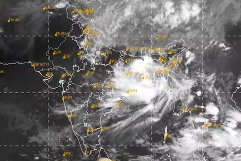India’s Mission Mausam
Mission Mausam was launched by the Government of India in September 2024. This initiative aims to enhance weather forecasting and manage specific weather events. The mission seeks to control rainfall, hail, fog, and later, lightning strikes.
Importance of Cloud Physics
Cloud physics is crucial for effective weather modification. It involves studying how clouds behave in different conditions. India needs to strengthen its research in this area. This will help in understanding and manipulating weather patterns more effectively.
To support this research is building a unique cloud chamber at the Indian Institute of Tropical Meteorology (IITM) in Pune. This chamber is designed to simulate cloud formation under controlled conditions.
What is a Cloud Chamber?
A cloud chamber is a closed cylindrical or tubular structure. Inside, water vapour and aerosols are injected. Under specific humidity and temperatures, clouds can develop. The Pune facility will allow scientists to study cloud droplets and ice particles in detail.
Features of the Pune Facility
Unlike basic cloud chambers found in many countries, the Pune facility will have convection properties. This makes it suitable for studying Indian monsoon clouds. There are only a few convective cloud chambers globally, making this facility.
Objectives of the Convective Cloud Chamber
The primary goal is to understand cloud behaviour during normal and extreme conditions. Scientists will study how rain droplets and ice particles form. They will also examine how moisture from cyclones affects the atmosphere. These interactions are vital for weather modification strategies.
Planned Research Activities
Scientists will tailor environmental parameters in the cloud chamber. They will adjust temperature, humidity, and convective conditions to study their effects on clouds. Senior IITM scientist Thara Prabhakaran emphasised the need for controlled environments to test new ideas.
Development Timeline
Over the next 18-24 months, the focus will be on creating advanced instruments and probes. These tools will monitor various conditions inside the chamber. Civil construction of the chamber will begin soon.
India’s Experience with Cloud Seeding
India has previously conducted cloud seeding experiments, notably the Cloud Aerosol Interaction and Precipitation Enhancement Experiment (CAIPEEX). This programme lasted over a decade and had four phases.
Results of CAIPEEX
In the last phase, experiments were conducted in Maharashtra’s Solapur district. Results showed that cloud seeding could enhance rainfall by up to 46% in some areas. On average, it increased rainfall by about 18% over a 100-square-kilometre area downwind of the seeding location.
Limitations of Cloud Seeding
Despite positive results, cloud seeding is not a comprehensive solution for rainfall issues. It has limitations and cannot be relied upon solely to address all weather-related challenges.
Mission Mausam and the establishment of the cloud chamber represent an important step towards advanced weather management in India. The research conducted here could lead to better understanding and control of weather phenomena, particularly during the monsoon season.
Month: Current Affairs - October, 2024
Category: India Nation & States Current Affairs








